7.1 Biogeographic Patterns
Identify and explain major geographic patterns of life on Earth.
Earth is covered by a continuous mantle of life. Everywhere, living creatures are rooting, swimming, drifting, flying, walking, crawling, climbing, and burrowing. Fern spores ride stratospheric winds. Bacteria reside in the depths of the oceans and kilometers deep within Earth’s crust. A single handful of healthy soil can hold hundreds of millions of beneficial soil microbes. Yet biodiversity (the number of living species in a specified region) is not arranged haphazardly across Earth’s surface. Patterns of life result from conditions that exist now and existed in the past.
biodiversity
The number of living species in a specified region.
Every species has a story to tell. Why it lives where it lives, what is currently preventing it from moving to other places, and what transpired in the past to bring it to its current geographic locations all are part of the story that biogeographers try to piece together. Biogeography is the study of the geography of life and how it changes through space and time. Biogeographers seek to understand why organisms live where they do. This information provides insight into the workings of Earth’s physical systems and a better understanding of Earth’s natural and human history. The roots of modern biogeography are often traced to the German explorer Alexander von Humboldt (1769–
biogeography
The study of the geography of life and how it changes through space and time.
Here are some questions a biogeographer might ask:
Why are there naturally no penguins in the Northern Hemisphere and no polar bears in the Southern Hemisphere?
Why are the tropics rich with species while biodiversity gradually decreases at higher latitudes?
Why are some species geographically widespread and others restricted to small areas?
How do terrestrial species like sunflowers reach remote places such as Hawai‘i?
How do people affect the geographic ranges of species?
How are new species formed, and what causes species to go extinct?
How do organisms respond to climate change?
The discipline of biogeography is closely tied to ecology, the study of the interactions between organisms and their environment. The ecosystem is a fundamental unit of ecology that includes both living organisms within a community and the nonliving components of the environment in which they live, such as energy, minerals, gases, and water.
ecology
The study of the interactions between organisms and their environment.
ecosystem
The living organisms within a community and the nonliving components of the environment in which they live.
Global Patterns of Biodiversity
Biodiversity is often measured by numbers of species: groups of individuals that naturally interact and can breed and produce fertile offspring. Why is it that some locations, such as the tropics, have many more species than others?
species
A group of individuals that naturally interact and can breed and produce fertile offspring.
The Latitudinal Biodiversity Gradient
Compared with higher latitudes, the tropics are bursting with species. Biodiversity is highest in the tropics and decreases toward the poles (Figure 7.2). This latitudinal biodiversity gradient is Earth’s most prominent small-
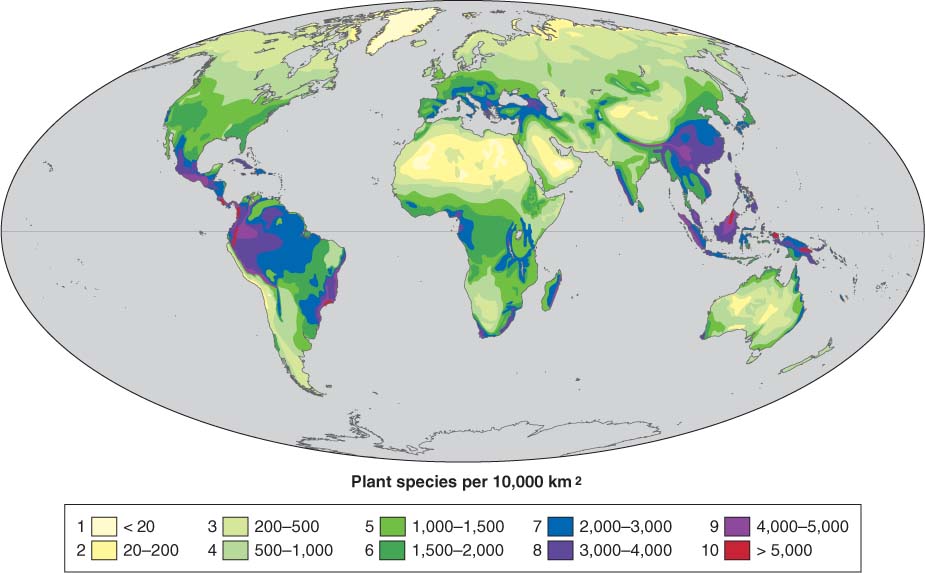
Scientists do not know why most of the tropics and subtropics are more biodiverse than the mid-
The most significant factor in the latitudinal biodiversity gradient appears to be the rate of plant growth. In other words, areas with abundant sunlight and water (such as the tropics) have both high plant growth rates and high biodiversity.
Picture This
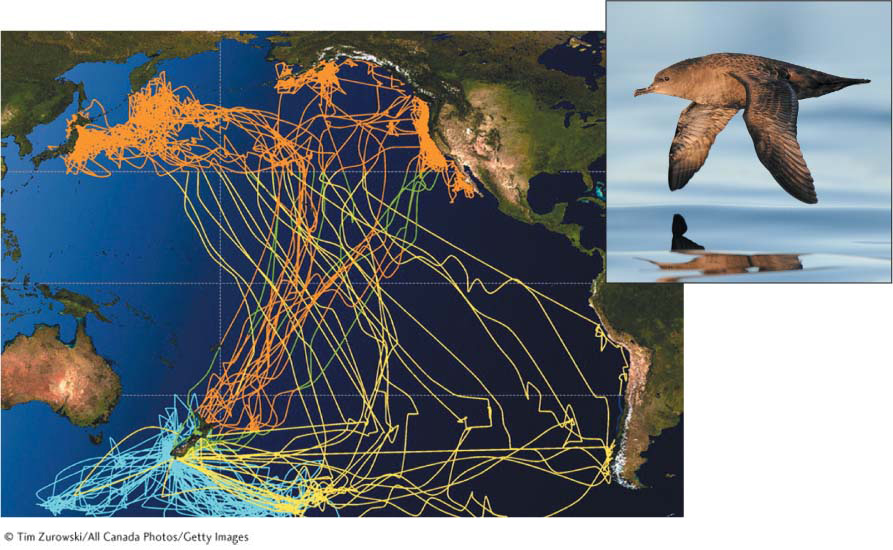
(© Tim Zurowski/All Canada Photos/Getty Images)
Sooty Shearwater Migration
The sooty shearwater (Puffinus griseus) never experiences winter. This seabird’s long-
Consider This
Question 7.1
How do you think the sooty shearwater knows where it is in such vast geographic space? What “map” is the bird using?
Question 7.2
What specific “push-
pull” factors can you think of that would compel the sooty shearwater to migrate such great distances?
Biogeographic Patterns among Islands
Another major spatial biogeographic pattern is found among islands: Larger islands tend to have more species than smaller islands (Figure 7.3). Islands are immensely interesting from a biogeographer’s perspective, and island biogeography is an important subdiscipline within biogeography.

In biogeography, the term island can refer to any habitat that is surrounded by an inhospitable environment. For instance, a freshwater pond that is surrounded by land can be a biogeographic island. Cold, isolated mountaintops surrounded by hot lowland desert are also biogeographic islands.
Migration
Biodiversity also changes across Earth’s surface over time as species migrate. Migration is the seasonal movement of organisms from one place to another, usually for feeding or breeding. Many species migrate latitudinally (north and south) and altitudinally (upslope and downslope) in response to changes in resource availability over time. Migration is a result of the “push” of dwindling resources in one region and the “pull” of increasing resources in another. As the organisms follow their resources, they create moving fronts of biodiversity. For example, many species of birds migrate to the Arctic to take advantage of the brief bounty of insects and plants in the Arctic summer. Thus, Arctic biodiversity increases between June and August. After the birds leave in fall, Arctic biodiversity decreases. Picture This shows the journey of one such bird, the sooty shearwater.
migration
The seasonal movement of populations from one place to another, usually for feeding or breeding.
Question 7.3
Why do animals migrate?
Animals migrate from areas where resources are in short supply to areas where they are more abundant.
Scientists make great efforts to track the movements of animals to understand their ecological requirements. Before the development of GPS technology, the migration patterns of many animals were poorly understood or unknown. Figure 7.4 details applications of GPS and other techniques used in tracking animal movement today.
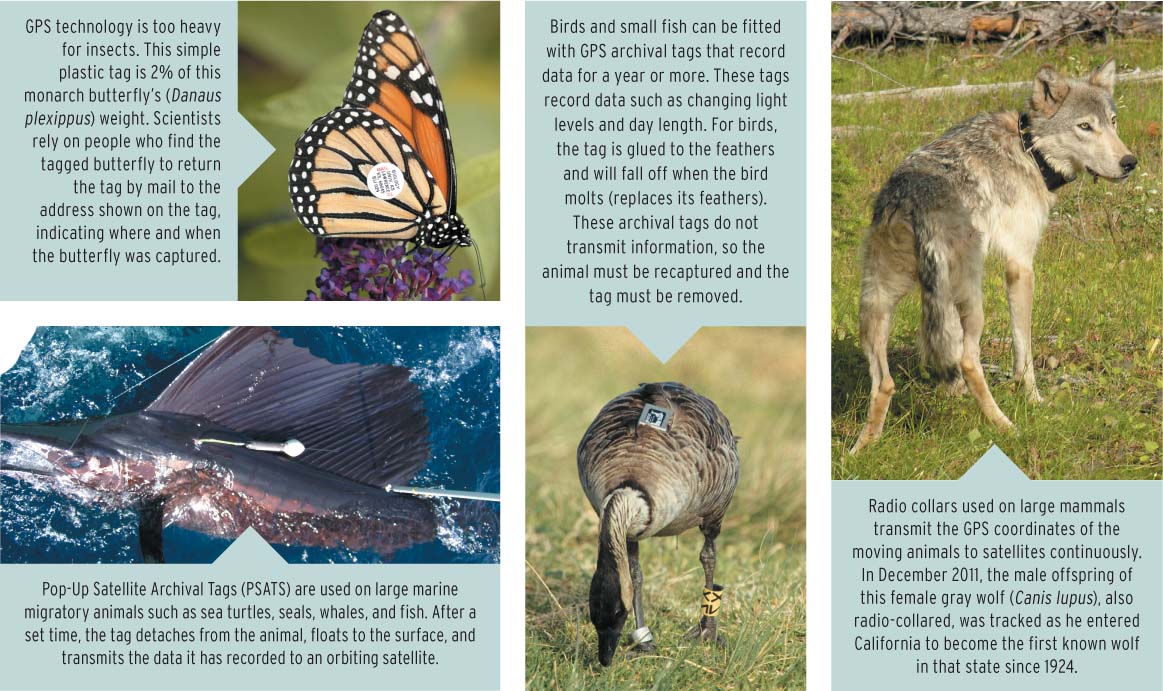
Patterns of Biodiversity Resulting from Evolution
Many interesting biogeographic patterns reveal the underlying process of evolution at work. Evolution is the process of genetically driven change in a population caused by selection pressures in the environment. A population is a group of organisms that interact and interbreed in the same geographic area. Through time, as genetic changes accrue, speciation will result. Speciation is the creation of new species through evolution. All organisms on Earth originated through the process of evolution and resulting speciation.
evolution
The process of genetically driven change in a population caused by selection pressures in the environment.
population
A group of organisms that interact and interbreed in the same geographic area.
speciation
The creation of new species through evolution.
Ideas about evolution were first developed by Charles Darwin (1809–
Observations That Support the Theory of Evolution
The theory of evolution is based on three observations:
• First, in nature, more offspring are produced than the environment can support. Because of resource limitations, the environment cannot support an unlimited number of individuals within a population.
Example: A single adult salmon can lay some 7,000 eggs. If all these eggs grew into adult fish and reproduced, the population of salmon would overwhelm the resources available after only a few generations.
• Second, populations are composed of genetically unique individuals. Most organisms result from sexual reproduction, in which half the genes of each parent are combined to create a genetically unique offspring. Populations are therefore composed of individuals with varying genetic traits.
Example: Most salmon are intolerant of warm water. Combinations of genes that confer a slightly higher tolerance for warm water could occur randomly in a few individuals within a population of salmon.
• Third, some of these genetic traits may be better than others at allowing an individual to cope with environmental stress.Through natural selection, those individuals with beneficial genetic traits are more likely to reproduce and pass on those traits to the next generation. In this way, the beneficial traits become more common in the population.
Example: As seawater warms, the warmth-
Patterns of Convergence
Through the process of evolution some unrelated organisms come to look strikingly similar. Convergent evolution is a process by which two or more unrelated organisms that experience similar environmental conditions evolve similar adaptations. All subtropical deserts, for example, impose similar selection pressures: intense sunlight, sparse vegetation cover, and persistent and severe moisture deficits. Because these environments select for the same traits, unrelated organisms in geographically isolated but similar desert environments may begin to look alike (Figure 7.5).
convergent evolution
An evolutionary process in which two or more unrelated organisms that experience similar environmental conditions evolve similar adaptations.
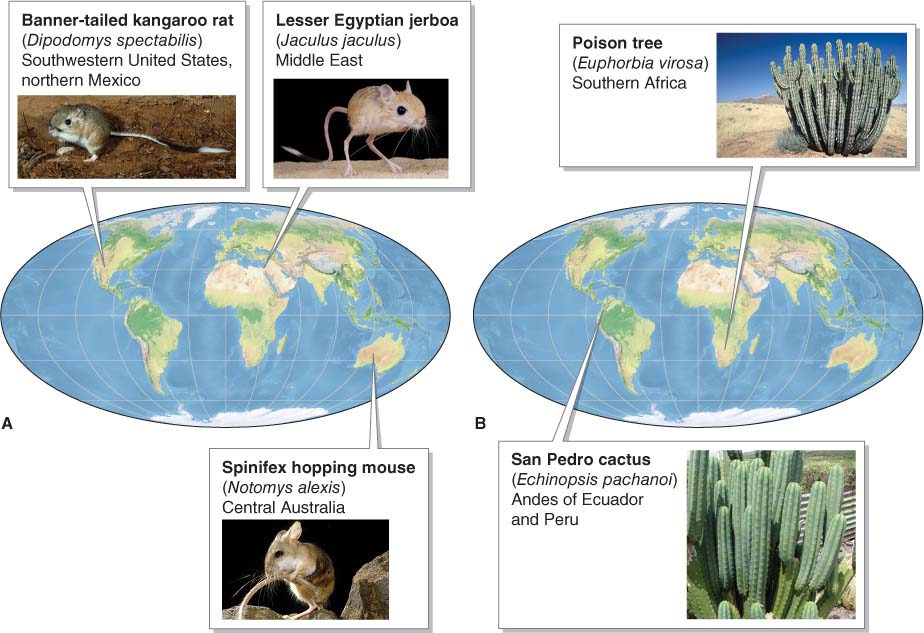
Patterns of Divergence
Another interesting biogeographic pattern seen on oceanic islands such as those of Hawai‘i is that of dispersal and divergent evolution. Dispersal is the movement of an organism away from where it originated. Hawai‘i, for example, is exceedingly remote from the mainland and was never connected to it. Therefore, native land organisms first colonized Hawai‘i by dispersing across the Pacific Ocean. Organisms that managed to reach Hawai‘i from the mainland became cut off from the mainland population from which they came. In a biological context, such isolation, called reproductive isolation, means that the two geographically separated populations are no longer interacting and that gene flow between them has stopped.
dispersal
The movement of an organism away from where it originated.
When populations become reproductively isolated, individuals within one population begin to diverge genetically from those in the other population through a process called divergent evolution. Those species that did disperse to Hawai‘i long ago diverged genetically from their mainland ancestors for two main reasons. First, they no longer interbred with and shared genes with those ancestors, and second, there were unique selection pressures on each of the islands that were not found on the mainland. Figure 7.6 uses Hawaiian honeycreepers to illustrate the concept of divergent evolution.
divergent evolution
An evolutionary process by which individuals in one reproductively isolated population evolve adaptations different from those of closely related individuals in another population.
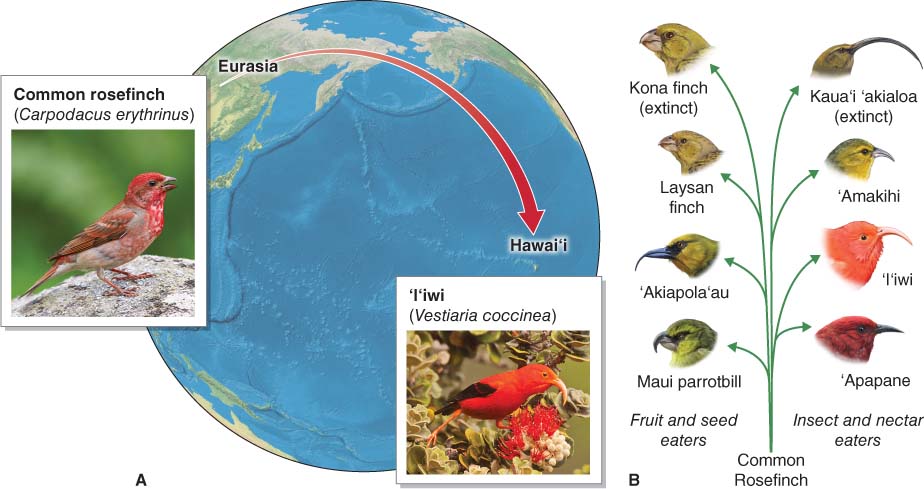
Biogeographic Regions
Evolutionary divergence acts on smaller (broader) spatial scales as well. Biogeographic regions are continental-
biogeographic region
A continental-
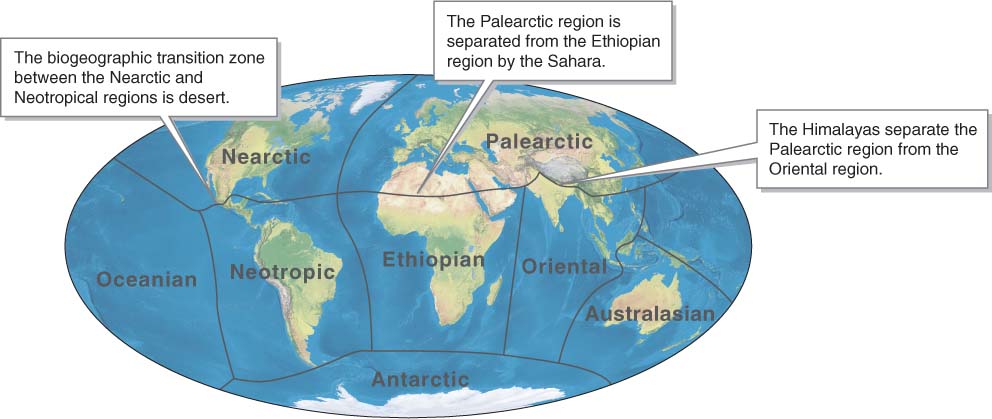
The edges of the biogeographic regions, called biogeographic transition zones, are found in areas such as deserts, mountains, and oceans that restrict movement of species and gene flow between regions, resulting in evolutionary divergence. The North American biogeographic region is called the Nearctic. Most plants and animals there are genetically distinct from those of the Neotropic biogeographic region to the south.